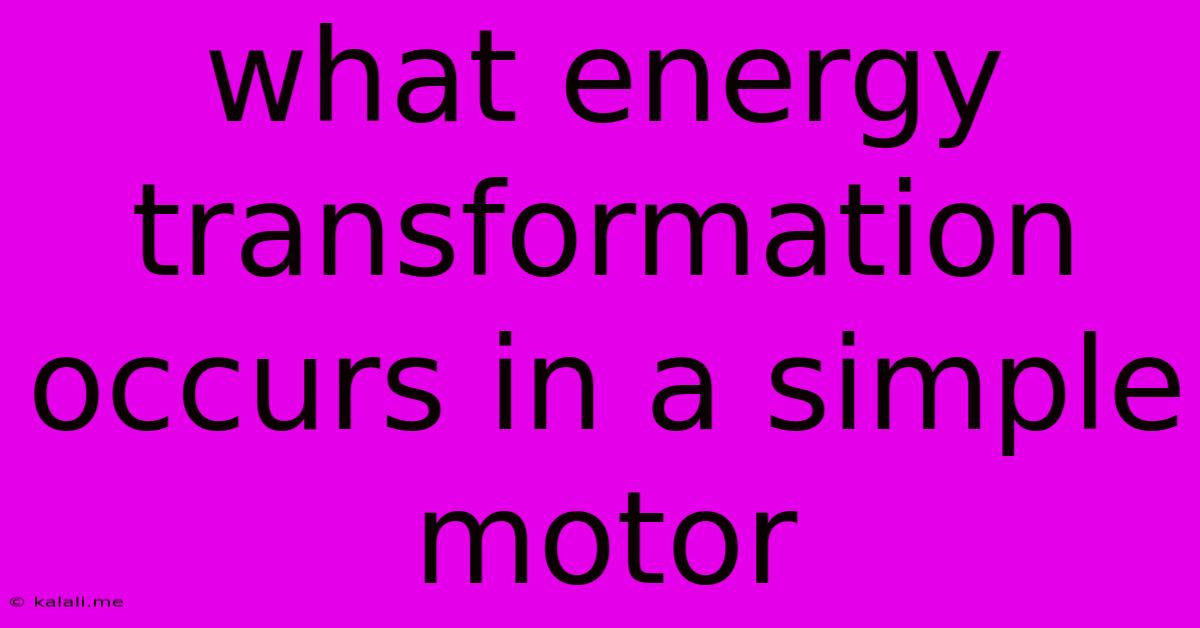What Energy Transformation Occurs In A Simple Motor
Kalali
May 08, 2025 · 3 min read

Table of Contents
What Energy Transformation Occurs in a Simple Motor?
A simple electric motor performs a fascinating energy transformation, converting electrical energy into mechanical energy. This seemingly simple process underpins countless technologies, from household appliances to powerful industrial machinery. Understanding the fundamental energy conversion within a motor is key to appreciating its functionality and broader implications in our technologically driven world. This article will delve into the specific processes involved, exploring the intricate steps that bridge the gap between electricity and motion.
The Core Principle: Electromagnetism
At the heart of a simple DC motor lies the principle of electromagnetism. This principle dictates that an electric current flowing through a conductor creates a magnetic field around it. This magnetic field interacts with another magnetic field, usually produced by permanent magnets, resulting in a force that causes motion.
Steps in the Energy Transformation
The transformation from electrical energy to mechanical energy involves several key steps:
-
Electrical Energy Input: The process begins with an electrical current supplied to the motor, typically via a battery or power source. This current provides the initial energy input.
-
Current Flow through the Armature: The current flows through a coil of wire, known as the armature, wound around a rotating core. The armature is crucial as it houses the conductor that interacts with the magnetic field.
-
Magnetic Field Generation: As the current passes through the armature, it generates its own magnetic field around the coil, according to the principles of electromagnetism. The strength of this magnetic field is directly proportional to the current flowing through the coil.
-
Interaction of Magnetic Fields: This newly generated magnetic field interacts with the magnetic field produced by permanent magnets within the motor. The interaction produces a force, specifically a torque or rotational force, on the armature. This interaction is governed by the fundamental laws of physics, particularly the Lorentz force.
-
Mechanical Rotation: This torque causes the armature to rotate, converting the electrical energy into kinetic energy (energy of motion). The rotation can be harnessed to drive various mechanical systems or perform work.
-
Commutator's Role (in DC Motors): In DC motors, a commutator plays a vital role. This segmented ring reverses the direction of the current flow in the armature at precisely timed intervals. This ensures the continuous rotation of the armature, preventing the motor from simply oscillating back and forth. AC motors achieve continuous rotation through different mechanisms.
Efficiency and Losses
While the transformation is conceptually straightforward, it’s not perfectly efficient. Some energy is lost as heat due to resistance within the wires and friction in the moving parts. The efficiency of a motor is a critical factor, as it determines how much of the input electrical energy is actually converted into useful mechanical work. Factors like the motor's design, materials, and operating conditions all affect its efficiency.
Beyond the Basics: AC Motors and More Complex Systems
While this explanation focuses on a simple DC motor, the fundamental principle of electromagnetic interaction remains the same in more complex motor types, including AC motors (alternating current motors). These motors utilise varying magnetic fields and different mechanisms to achieve continuous rotation, but the underlying energy transformation from electrical to mechanical energy persists.
In conclusion, the energy transformation within a simple electric motor is a beautiful example of fundamental physics in action. It showcases the power of electromagnetism in converting electrical energy into the mechanical energy that drives so many aspects of our modern world. Understanding this fundamental process opens doors to a deeper appreciation of electrical engineering and the technologies that shape our daily lives.
Latest Posts
Latest Posts
-
What Type Of Symmetry Do Platyhelminthes Have
May 09, 2025
-
Convert 58 Degrees Fahrenheit To Celsius
May 09, 2025
-
65 Cm In Inches And Feet
May 09, 2025
-
How Much Is 20 Of 300
May 09, 2025
-
Living And Nonliving Things In An Ecosystem
May 09, 2025
Related Post
Thank you for visiting our website which covers about What Energy Transformation Occurs In A Simple Motor . We hope the information provided has been useful to you. Feel free to contact us if you have any questions or need further assistance. See you next time and don't miss to bookmark.